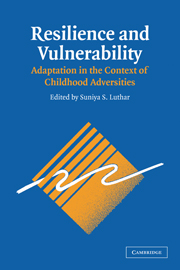Book contents
- Frontmatter
- Contents
- List of Contributors
- Foreword by Dante Cicchetti
- Preface
- 1 A Resilience Framework for Research, Policy, and Practice
- PART I FAMILIAL ADVERSITIES: PARENTAL PSYCHOPATHOLOGY AND FAMILY PROCESSES
- 2 Young Children with Mentally Ill Parents: Resilient Developmental Systems
- 3 Risk and Protective Factors for Children of Depressed Parents
- 4 Resilience and Vulnerability among Sons of Alcoholics: Relationship to Developmental Outcomes between Early Childhood and Adolescence
- 5 Maternal Drug Abuse versus Other Psychological Disturbances: Risks and Resilience among Children
- 6 Resilience to Childhood Adversity: Results of a 21-Year Study
- 7 Sequelae of Child Maltreatment: Vulnerability and Resilience
- 8 Risk and Resilience in Children Coping with Their Parents' Divorce and Remarriage
- 9 Correlational and Experimental Study of Resilience in Children of Divorce and Parentally Bereaved Children
- PART II EXOSYSTEMIC AND SOCIODEMOGRAPHIC RISKS
- PART III COMMENTARIES
- Index
- References
2 - Young Children with Mentally Ill Parents: Resilient Developmental Systems
Published online by Cambridge University Press: 05 June 2012
- Frontmatter
- Contents
- List of Contributors
- Foreword by Dante Cicchetti
- Preface
- 1 A Resilience Framework for Research, Policy, and Practice
- PART I FAMILIAL ADVERSITIES: PARENTAL PSYCHOPATHOLOGY AND FAMILY PROCESSES
- 2 Young Children with Mentally Ill Parents: Resilient Developmental Systems
- 3 Risk and Protective Factors for Children of Depressed Parents
- 4 Resilience and Vulnerability among Sons of Alcoholics: Relationship to Developmental Outcomes between Early Childhood and Adolescence
- 5 Maternal Drug Abuse versus Other Psychological Disturbances: Risks and Resilience among Children
- 6 Resilience to Childhood Adversity: Results of a 21-Year Study
- 7 Sequelae of Child Maltreatment: Vulnerability and Resilience
- 8 Risk and Resilience in Children Coping with Their Parents' Divorce and Remarriage
- 9 Correlational and Experimental Study of Resilience in Children of Divorce and Parentally Bereaved Children
- PART II EXOSYSTEMIC AND SOCIODEMOGRAPHIC RISKS
- PART III COMMENTARIES
- Index
- References
Summary
Mental illness is a family matter. When one member has mental illness, it affects all others in the family. In their simplest forms, the distress and functional impairment of the ill family member are felt on a daily basis by others in the household – in ways that range from empathizing with the distress, to disruption of interpersonal relationships within the family, to compromised family functioning in which tasks of daily life are not accomplished. At a more complex level, when the mentally ill family member is a parent, there are well-established risks for the children in that family. Rates of mental illness are higher throughout the children's lifespan (particularly during the typical risk periods for mental illnesses), difficulties in school are more frequent, and problems in general social adjustment (such as delinquent behavior) are manifest. Still, the mechanisms by which this risk is manifest remain obscure.
In this chapter, I describe the current state of our knowledge regarding resilience in infants and young children who have a parent with mental illness. I begin by addressing some basic issues regarding how general models of resilience may be adapted to the particular circumstances of infants and toddlers. Following this, I summarize relevant research that may be interpreted in a resilience framework. I conclude with a summary model of processes identified to date in this population, along with some commentary on how well the resilience model will ultimately serve to aid understanding in this field.
- Type
- Chapter
- Information
- Resilience and VulnerabilityAdaptation in the Context of Childhood Adversities, pp. 29 - 49Publisher: Cambridge University PressPrint publication year: 2003
References
- 16
- Cited by



